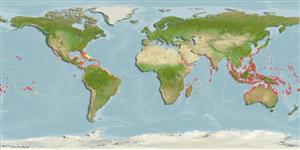Common names from other countries
>
Syngnathiformes (Pipefishes and seahorses) >
Syngnathidae (Pipefishes and seahorses) > Nerophinae
Etymology: Microphis: Greek, mikros = small + greek, ophis = serpent (Ref. 45335).
More on author: Bleeker.
Environment: milieu / climate zone / depth range / distribution range
Sinh thái học
Biển; Nước ngọt; Thuộc về nước lợ gần đáy; di cư biển sông (để đẻ trứng) (Ref. 51243); Mức độ sâu 0 - 5 m (Ref. 86942). Subtropical; 35°N - 32°S
Asia and Oceania: Sri Lanka, southern India, Nicobar Islands and eastward to Japan and the Society Islands. Records from Puerto Rico and USA need confirmation. Africa: east coast from Kenya south to KwaZulu-Natal area, also Madagascar and Mauritius (Ref. 7248, 52193). Africa: Côte d'Ivoire (Ref. 272). Western Atlantic: Atlantic coast of Florida, Bahamas, northern and southern Gulf of Mexico, Antilles, central and south American coasts to Brazil (Ref. 26938).
Length at first maturity / Bộ gần gũi / Khối lượng (Trọng lượng) / Age
Maturity: Lm ?, range 12 - ? cm
Max length : 22.0 cm SL con đực/không giới tính; (Ref. 5316)
Các tia vây lưng cứng (tổng cộng) : 0; Các vây lưng mềm (tổng cộng) : 37 - 54; Tia cứng vây hậu môn: 0; Tia mềm vây hậu môn: 4.
Occurs in relatively shallow (25-150 cm), still to slow-flowing water (Ref. 6028). Inhabits freshwater streams, rivers and estuaries. Juveniles and subadults are usually found in estuaries while adults are found upstream in freshwater areas. Feeds on worms, crustaceans and zooplankton. Ovoviviparous (Ref. 205). The male carries the eggs in a brood pouch which is found under the tail (Ref. 205). Not seen in markets (Ref. 12693)
Female deposits eggs on the ventral surface of the male trunk's or tail , where they are incubated for several weeks. Males may be brooding at 12 cm SL (Ref. 5316).
Dawson, C.E., 1985. Indo-Pacific pipefishes (Red Sea to the Americas). The Gulf Coast Research Laboratory Ocean Springs, Mississippi, USA. (Ref. 5316)
IUCN Red List Status (Ref. 130435)
CITES (Ref. 128078)
Not Evaluated
Threat to humans
Harmless
Human uses
Các nghề cá: không ích lợi (thú vị); Bể nuôi cá: Tính thương mại
Các công cụ
Special reports
Download XML
Các nguồn internet
Estimates based on models
Preferred temperature (Ref.
115969): 25.4 - 29.2, mean 28.1 (based on 3402 cells).
Phylogenetic diversity index (Ref.
82804): PD
50 = 0.5000 [Uniqueness, from 0.5 = low to 2.0 = high].
Bayesian length-weight: a=0.00085 (0.00032 - 0.00224), b=3.04 (2.81 - 3.27), in cm Total Length, based on LWR estimates for this (Sub)family-body shape (Ref.
93245).
Mức dinh dưỡng (Ref.
69278): 3.3 ±0.41 se; based on food items.
Thích nghi nhanh (Ref.
120179): Chiêù cao, thời gian nhân đôi của chủng quần tối thiểu là dưới 15 tháng (Preliminary K or Fecundity.).
Fishing Vulnerability (Ref.
59153): Low vulnerability (17 of 100).
